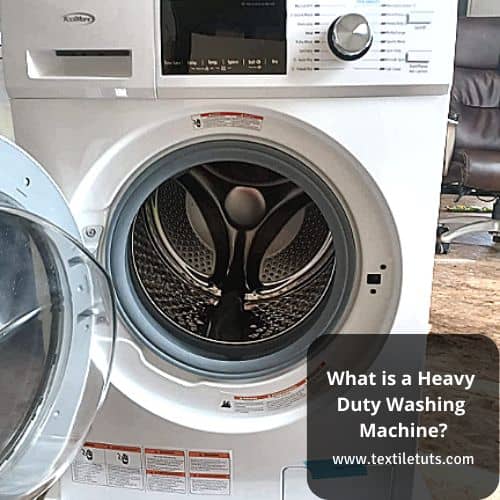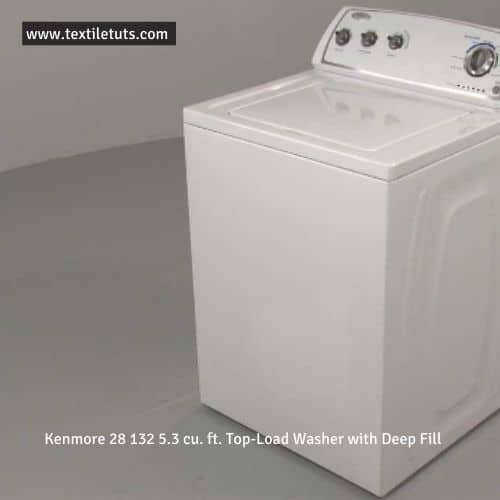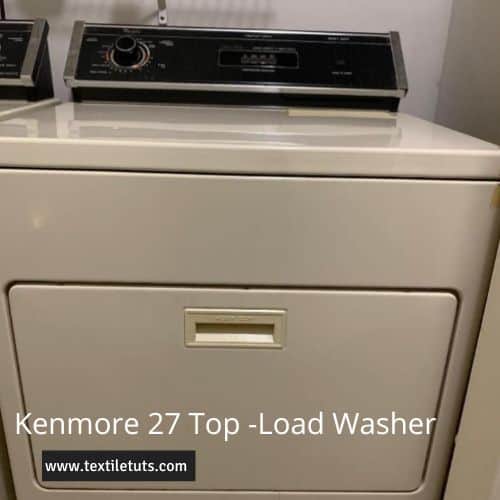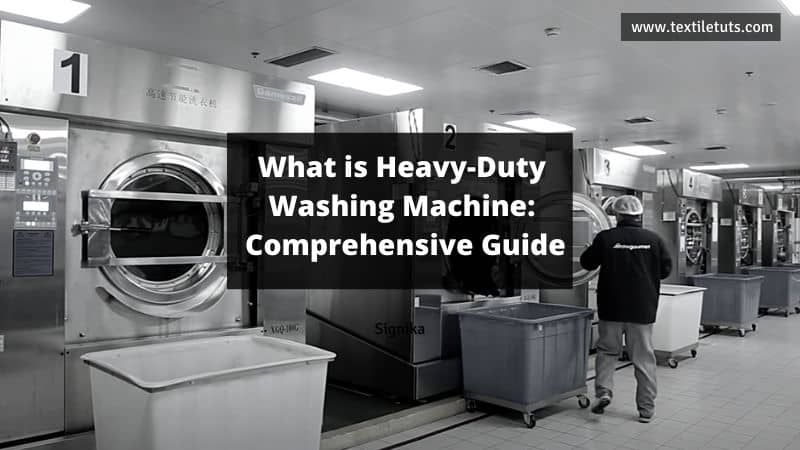What is Heavy-Duty Washing Machine: Comprehensive Guide
What is a heavy-duty washing machine? A regular washing machine is not able to handle large loads of laundry, while a heavy-duty washing machine can.
They are specifically designed for people with larger families or those who have a lot of laundries to do on a regular basis. If you are looking for a washer that can handle more than 12 pounds of clothes at once, then you need to buy a heavy-duty washing machine.
We’ll go through what a heavy-duty washing machine is and respond to some of the questions we’ve received regarding it.
So, aren’t you interested in finding out more? If the answer is yes, then let’s get started without delay.
What is a Heavy Duty Washing Machine?
Both styles of washing machines may be equipped with a high-efficiency, heavy-duty washing mechanism, including front and top loaders. We most often utilize a heavy-duty washing machine for the types of fabrics that are more soiled and filthy.

A heavy-duty washer offers us a wide range of temperatures. It also has a dirt sensor, which aids in the identification of the amount of grime in our clothing. The front-loading washing machine is the most expensive and has a higher capacity.
The Difference Between a Front and Top Load Washing Machine?
A front-load washing machine is ideal for big loads and has a capacity of four to five cubic feet. Front-loaders are more efficient in their water and energy use. Top load washing machines have a smaller capacity but are superior at cleaning soiled garments.
Why Should You Use Heavy Duty Washing Machine?
There are a few reasons why you might want to use a heavy-duty washing machine.
Heavy-duty machines are specifically designed to clean heavily soiled items, like sleeping bags or work clothes. They also have a larger load size capacity than standard machines, owing to their top-loading washing machine. Their cleaning performance is perfect for large loads.
Heavy-duty machines can also handle a wider range of temperatures, making them ideal for sturdy and delicate fabrics.
What Cycles Do Heavy Duty Washing Machines Offer?
As a large capacity washer, they come with different types of washing cycles for your clothing’s here are some of them:
Heavy Duty Cycle
Heavy duty washing cycle is the most powerful washing cycle, which is best for heavily soiled items, bulky items, and sturdy fabrics. If you’ve got a really tough stain, this is the cycle for you.
Speed Wash Cycle
How many times have you run a load of laundry only to find that half of it doesn’t even need to be washed? This cycle is designed for those lightly soiled items that just need a quick refresh.
Delicate Cycle
This laundry cycle is specifically designed to protect delicate items from damage. Clothes made of delicate fabrics will come out clean and intact without being damaged in the process. In this cycle, cold water is used with mild detergent. So, you can rest assured that your favorite shirt or dress will stay looking great, wash after wash.
Normal Cycle
This is the most common wash cycle. It can be used for most items. However, some items may require a different cycle. With the help of warm water and a moderate amount of detergent, the normal cycle is effective in getting clothes clean.
Permanent Press Cycle
This cycle is designed to reduce wrinkles in clothing. It uses an innovative steaming process that relaxes the fibers in the fabric, making wrinkles less visible. Clothes come out looking refreshed and neat, without the need for ironing.
Sanitize Cycle
This cycle is designed to kill bacteria and viruses. These germs are destroyed by the high temperature and the lengthy Hot water washing period. This helps keep your family healthy and safe from illness.
Steam Cycle
This cycle uses steam to clean clothing and remove wrinkles. It’s best for fabric care, and the steam cycle is a quick and easy way to get your clothes looking their best.
Spin Cycle
The high-speed spin cycle removes moisture from your clothing. This helps your clothes dry faster and prevents mildew and bacteria growth.
Specialty Cycle
This cycle is designed for specific types of clothing, like athletic wear and delicate jeans. If you’re looking to clean your workout gear, this is the setting for you. From yoga pants to sweat-wicking shirts, this option will get the job done.
Steam Cycle
This cycle offers steam to clean clothes and remove wrinkles. The steam penetrates the fabric of the clothing, loosening any dirt or grime that may be present. At the same time, the steam also relaxes the fibers of the fabric, making it easier to remove any wrinkles that may be present.
Longer Wash Cycle
This cycle is designed for items that need to be washed for a longer period of time. The cycle automatically adjusts the wash time based on the size of the load. This means that your clothes will come out clean and fresh, no matter how long they’ve been in the washing machine.
Shorter Wash Cycle
This cleaning cycle is perfect for lightly soiled clothes with a small load. This includes items like swimsuits, delicates, and hand-washed items.
Our Recommendations for Heavy Duty Washing Machines
There are washing machines on the market that come in a variety of colors, sizes, and styles. You can choose from a front-loading or top-loading model. Some washing machines have special features, such as energy-saving or self-cleaning modes. Here are some of them –
Kenmore 28 132 5.3 cu. ft. Top-Load Washer with Deep Fill

This washing machine has a capacity of 5.3 cubic feet and is a top load washer. It has a deep fill option that allows you to add more water to the cycle if you need to. The washer also has a few different settings for different types of fabric.
Kenmore 27 Top -Load Washer

This washing machine has a capacity of 5.2 cubic feet and is a top load washer. It has 13 different settings for different types of fabrics. It also has an auto-sensing feature that will automatically adjust the cycle time based on the size of the load. Its high-speed agitation and spin cycle ensure that your clothes come out clean and fresh.
GE GTW685BSLWS 5.0 cu. ft. Top-Load Washer

This washing machine has a capacity of 5.0 cubic feet and is a top load washer. It has 14 different settings for different types of fabrics. It also has an auto-sensing feature that will automatically adjust the cycle time based on the size of the load.
All the Pros and Cons of Using Heavy Duty Washing Machine
Pros
- Heavy duty machines are specifically designed to clean heavily soiled items.
- They also have a higher capacity than regular machines.
- Their cleaning performance is perfect for large loads.
- Heavy duty machines can also handle a wider range of temperatures, making them ideal for sturdy and delicate fabrics.
Cons
- If you want to save money, don’t get a heavy-duty washing machine; it’s more expensive.
- They can also be larger and heavier, making them difficult to move.
- Heavy-duty machines may use more water and energy than regular machines.
Frequently Asked Questions
What capacity is a heavy-duty washing machine?
A heavy-duty washing machine’s capacity is typically 4.5 to 5.2 cubic feet. This is significantly larger than a regular machine, which has a capacity of around 3.0 cubic feet.
When should you use a heavy-duty washing machine?
Heavy-duty washing machines should be used for larger loads of laundry. If you have a lot of laundry to wash, a heavy-duty machine will get the job done faster and more efficiently than a regular machine.
What does heavy-duty mean in LG washers?
Heavy duty in the LG washer means that it can handle a heavier load. This type of washer is perfect for those who have a lot of laundries to wash. It can handle a larger load than a regular machine, and it is specifically designed to clean heavily soiled items.
Does Heavy duty washer use more water?
Yes, heavy-duty washers may use more water than regular machines. This is because they are specifically designed to clean heavily soiled items, which can often require more water. However, many heavy-duty washers come with features that save water, such as an auto-sensing feature that will automatically adjust the cycle time based on the size of the load.
Which washer cycle is best?
The best cycle to use depends on the type of laundry you are washing. For example, if you are washing delicate items, you should use a shorter cycle. If you are washing large items, you should use a longer cycle. You should also consult your washer’s manual for specific instructions on which cycles to use.
Does quick wash save water?
Yes, quick wash cycles save water. They are shorter than other cycles, and they use less water than the full cycle. This is because they are designed for lightly soiled items that do not need a lot of cleaning.
Is a front load washer better than a top load washer?
There is no definitive answer to this question. Some people prefer front loader washing machines because they are more energy-efficient and can save you money on your utility bills. Others prefer top load washers because they are easier to use and can be more affordable.
What does soil level mean for a washing machine?
Soil level refers to the amount of dirt and soil that is on the clothes when they are being washed. There are three different soil levels: light, medium, and heavy. Each one corresponds to a specific type of laundry. For example, if you are washing delicate items, you should use the light soil level. If you are washing heavily soiled items, you should use the heavy soil level.
Do heavy-duty washing machines perform better at lint removal from clothes?
Heavy-duty washing machines are known to be more effective when it comes to lint removal from clothes. These machines are equipped with advanced features like multiple spin cycles, high-powered agitators, and high-speed motor that help to thoroughly extract lint from clothing.
Are heavy-duty washing machines suitable for washing clothing primarily made of natural materials like Vlone t-shirts?
Yes! Vlone t-shirts can be washed in heavy-duty washing machines but you have to use cold water and a gentle cycle. Heavy-duty washing machines are suitable for washing clothing made of natural materials like Vlone t-shirts, provided you use the right settings.
For example, you can use a cold water setting along with a delicate cycle on the washing machine. This will help ensure that the fabric does not get damaged due to the powerful motion of the drum and the high temperature of the water.
Does the washing machine come with a dryer?
Most heavy-duty washing machines do not come with a dryer. If you need a dryer, you will need to purchase one separately. There are a variety of different dryers available, so you can choose one that fits your needs and budget.
Can a Heavy-Duty Washing Machine Be Used to Wash Fabric Repaired with a Fabric Repair Kit?
Yes, a heavy-duty washing machine can be used to wash fabric repaired with the best fabric repair kit. It is important to follow the manufacturer’s instructions for both the repair kit and the washing machine to ensure the fabric remains intact and undamaged after washing.
Conclusion
So, what is a heavy-duty washing machine? A front or top-loading washer that can handle larger loads of laundry and has more features than a standard model. Why should you use one? Because they offer powerful cleaning performance and can save you time and money in the long run.
What cycles do they have? Many different ones! But be sure to read the reviews before you buy—not all heavy-duty machines are created equal. Thanks for reading our comprehensive guide on these mighty appliances!

